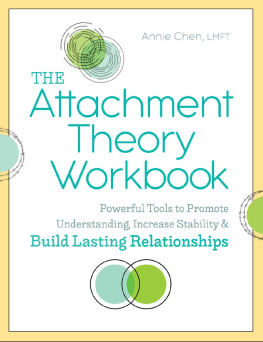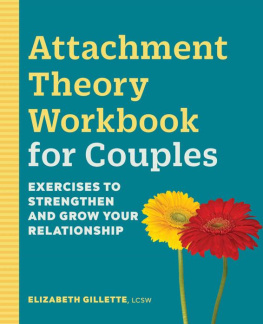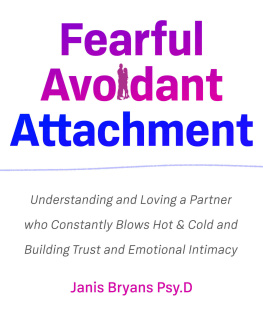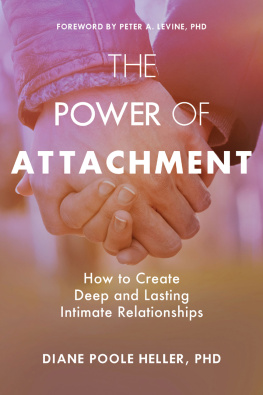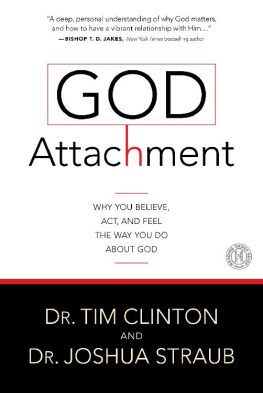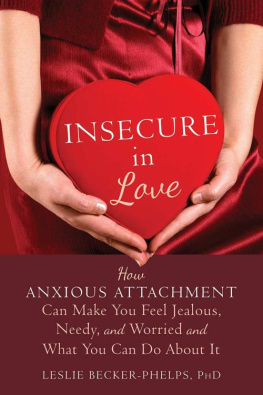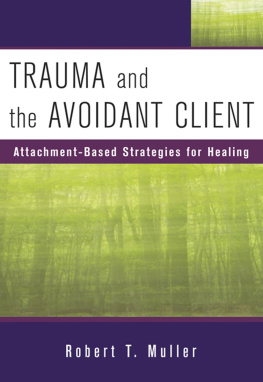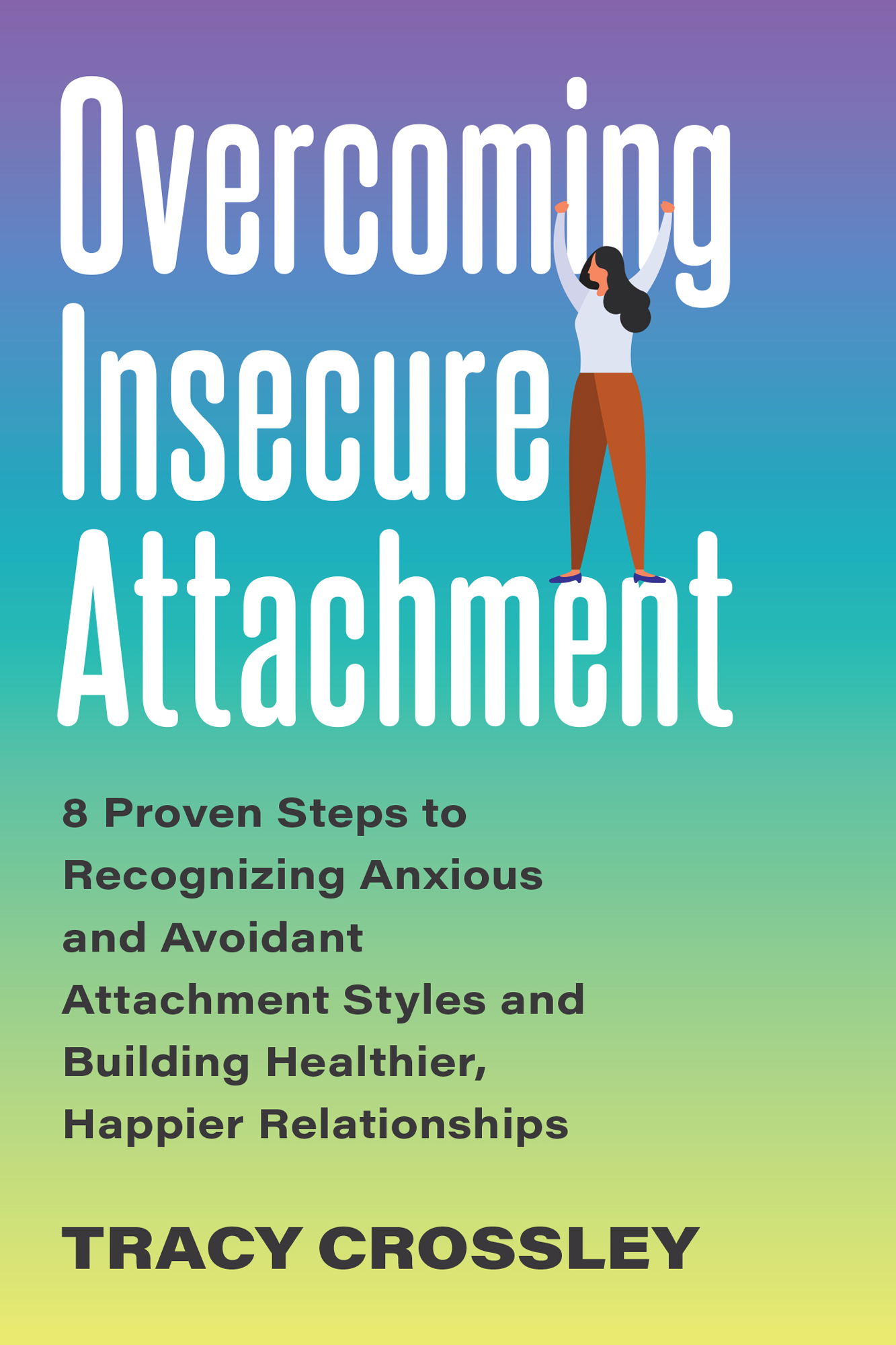Contents
Guide
Overcoming Insecure Attachment
8 Proven Steps to Recognizing Anxious and Avoidant Attachment Styles and Building Healthier, Happier Relationships
Tracy Crossley
To my husband, Davidmy rock, my greatest support, and my love!
Preface
I wish I had this book back when I was struggling. I was in so much emotional pain because of how I chose to live my life. I was a perfectionist, a people pleaser, and an emotional avoidant who had an anxiety problem. On top of this, I spent a ton of time solving everyone elses problems while pretending I had none of my own. I was an expert at hiding my pain.
No one really knew how much I suffered. Even if someone had an inkling, I would make sure they understood it was a temporary setback which I was resolving quickly. I could not handle anyone feeling sorry for me or giving me unwanted advice. I thought I knew it all.
Being a perfectionist and a problem-solver meant I could never rest on my laurels. I was always doing and striving to get validation from my accomplishments. When I did not get that validation, I punished myself. Somehow, I needed to suffer when I was rejected, disappointed, made mistakes, or did something else that could possibly put a chink in how I was perceived by the rest of the world.
I dont want to leave you alone on the same road, driving around in circles looking for the turnoff to happiness. Thats why I wrote this book.
MY JOURNEY TO EMOTIONAL FREEDOM
I am a behavioral relationship expert trained in a form of ontological coaching, which brings together body, mind, and soul. This style of coaching leads individuals to more self-awareness based on their way of being; it addresses issues from an emotional, somatic, and spiritual perspective.
My work has centered on emotional connectionwith ourselves and with others. I have helped thousands of people get out of their thinking minds and take emotionally driven actions that break the patterns that keep them stuck and unhappy. Breaking these patterns leads to true authenticity, emotional freedom, and happiness. It is hard work but truly transformative.
In this book, the Eight Steps to Self-Awareness, Love, and Happiness come from my front-row experience with deep and lasting personal transformation in myself and in my clients.
I did not start off in coaching. I have been an entrepreneur all my life, from selling popcorn balls on the street corner as a kid to having my own successful graphic design/marketing business as an adult. In between businesses, I worked in corporate management, marketing and sales, and a variety of other industries. No matter what I did, I found myself helping people. I was a problem-solver extraordinaire! Whether I was mentoring someone at work or assisting clients with their personal situations, the joy I got from helping people gave me an inkling of my true calling.
But I had this warped idea about what happiness was. I thought if I could just become successful enough at my businesses and relationships, everything would fall into place and I would land myself a patch of nirvana and feel better. Meanwhile, I suffered, looking for the perfect answer to my imperfect life.
FROM BLAME TO ACCOUNTABILITY
I knew I needed professional help for my constant anxiety, my revolving yo-yo relationships, and the inner emptiness that haunted me. Like millions of others, I went to therapy and consulted with a variety of other healers. I became very good at articulating my problems and what I was doing to solve them. In fact, I got so good at intellectualizing my problems that one therapist I saw threw her hands up in the air and told me I was too evolved a being for her to help! It was disappointing, but looking back, I know that I brought it on myself. I knew how to talk the talk.
Each time I went to therapy, things would improve somewhatbut sooner or later I would find myself back in the dumps. I would feel relieved for a moment, and then the same thing would happen again. I could think through situations and know the right thing to do, but I kept falling back into my old patterns. Nothing seemed to work. Id buy more books and seek out more help, but I still felt awful.
It was frustrating, but it also fueled my desire to feel better. One good trait of perfectionists and problem-solvers is we dont give up easily or settle for very long. My bigger insecurity was letting somebody know just how deep my soul-sucking insecurities ran. This I had to hide at all costs. I would have cringed had anyone known I did not have my act together.
One day, while walking down the street with ever-recurring problems on my mind, I experienced a major epiphany: I was, in fact, my own problem, a problem I could not solve in the way I had been trying to. I always thought information would be the answer. I always thought I did things the right way, and it was really others who would not cooperate. That day, I saw that I had never taken responsibility for my own choices and experiences. I was, in fact, a blamer!
This first epiphany was followed by a second, even more powerful one: I realized that until I got a clue about what was really going on inside of me emotionally, nothing outside of me would change. I saw how I had been avoiding my real emotions like they were the flu. No way had I been willing to scratch the scab on that wound!
These epiphanies hit me so hard that I had to catch my breath. I stopped walking, and standing on the sidewalk, I heard myself think, You will work through your emotions until you can move on peacefully. Even if you want to run, avoid, or blame, you will stay with how you feel and not react out of old thinking. No more of this crap. I had no idea what the hell staying with my feelings entailed, but I eventually learned, and my life began to change.
This transformation took a long timeyears. I found it mind-boggling trying to understand how to connect the dots between my intellectualizing, my perfectionist and people-pleasing behaviors, my poor choices, the abusive voice in my head, and my constant worry and suffering. Not only that, it was hard to see how truly awful I felt about myself. I recognized how little I understood the concept of self-love or how to apply it to myself. I just knew that I was never going to feel any different unless I took my epiphany seriously.
I was just beginning my coaching business and in yet another dysfunctional relationship I couldnt get right. I decided to use this on again/off again relationship to discover all the things I was doing that were causing me pain. Up until this point, I had really believed it was all him. Why couldnt he get it right, so we could ride off into the sunset together? Oh, brother, did I have a big corner to turn! Without holding my breath, I dove deep into the beliefs that propelled me to act in the dysfunctional ways I did. I needed to understand why I felt I wasnt worth much, even though I had achieved so much in my life. I continued to read a lot of self-help books, as I had done for years, but started to see how none of them could tell me how to change myself and be happy. Because of my epiphany, I knew that connecting to myself emotionally was the key.
It took many years of trial and error before I mastered this. I had to accept that I was screwed up, yet still lovable and wonderful. That sounded horrible. It also sounded impossible. But slowly, I noticed things about myself. Each time I got triggered into anxiety or other agonizing emotional states, I found that these emotions actually had very little to do with the situation at hand. Most of my feelings were from reactions specifically related to past experiences and the stories I had about them. I had to dive even deeper within myself, to a place beyond my surface reactionary emotions. This was tricky business, because how do you connect with something within yourself that you dont even know exists?



